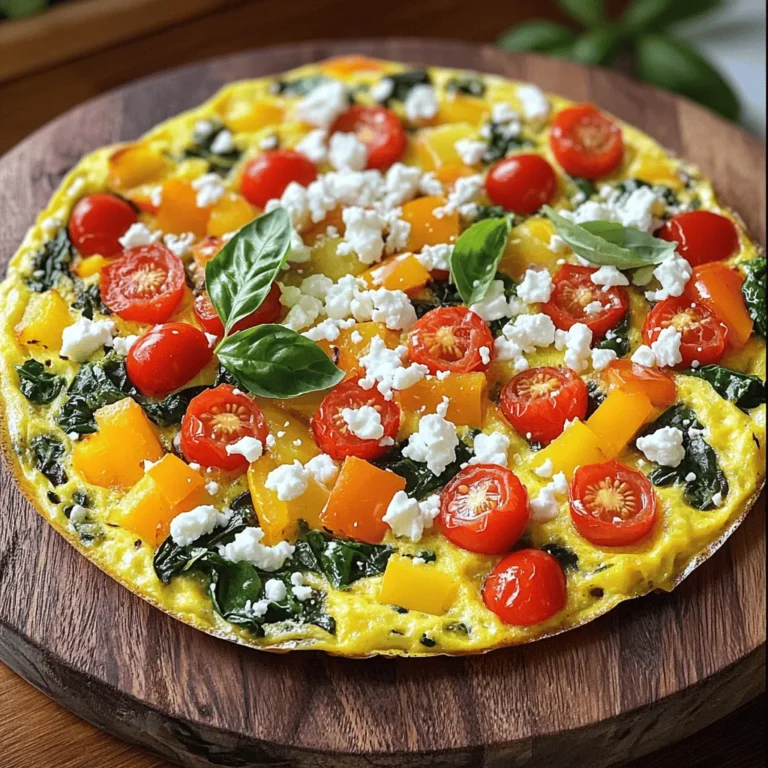Want to whip up a tasty meal that’s quick and easy? This savory vegetable frittata is the answer! Packed with delicious veggies and rich flavors, it’s a fantastic way to enjoy a healthy dish any time of the day. Whether you’re cooking for breakfast, brunch, or dinner, I’ll guide you through simple steps to create this delightful frittata. Let’s dive into the fresh ingredients and flavorful techniques!
Ingredients
List of Ingredients
To make a savory vegetable frittata, gather these ingredients:
- 6 large eggs
- 1 cup spinach, chopped
- 1/2 cup bell peppers (any color), diced
- 1/2 cup cherry tomatoes, halved
- 1/4 cup red onion, finely chopped
- 1/4 cup feta cheese, crumbled
- 1/4 cup milk (or dairy-free alternative)
- 2 tablespoons olive oil
- 1 teaspoon garlic powder
- 1 teaspoon dried oregano
- Salt and pepper to taste
- Fresh herbs (basil or parsley) for garnish
Key Vegetables for Flavor
The right vegetables bring life to your frittata. Spinach adds a soft, slightly earthy taste. Bell peppers add sweetness and crunch. Cherry tomatoes offer juicy bites that burst with flavor. Red onion gives a mild sharpness that balances the dish. These veggies not only taste great but also bring color and nutrition.
Dairy and Egg Options
Using eggs is classic for frittatas. They provide protein and a creamy texture. You can choose whole milk for richness, or try a dairy-free milk for a lighter option. Feta cheese adds tang and creaminess. Feel free to switch it up with other cheeses like cheddar or goat cheese for different flavors. For a vegan option, you can use silken tofu blended until smooth instead of eggs.
Step-by-Step Instructions
Prepping the Oven and Skillet
Start by preheating your oven to 350°F (175°C). This step is key for cooking the frittata evenly. Next, grab your large, oven-safe skillet. I love using cast iron for this recipe, as it holds heat well.
Sautéing the Vegetables
Pour 2 tablespoons of olive oil into the skillet. Heat it over medium heat. Once hot, add the finely chopped red onion and diced bell peppers. Cook these for about 3-4 minutes. You want them soft but not browned. Now, stir in the chopped spinach and halved cherry tomatoes. Cook until the spinach wilts, about 2-3 minutes, then remove the skillet from the heat.
Mixing the Egg Mixture
In a separate bowl, whisk together 6 large eggs, 1/4 cup milk, and seasonings. This includes 1 teaspoon of garlic powder, 1 teaspoon of dried oregano, and a pinch of salt and pepper. Make sure to whisk until everything is well mixed and fluffy.
Combining Ingredients
Pour your egg mixture over the sautéed vegetables in the skillet. Gently stir to combine. Now, sprinkle 1/4 cup of crumbled feta cheese evenly on top. This cheese adds a nice tangy flavor to the dish.
Cooking on the Stovetop and Baking
Cook the frittata on medium heat for about 3-5 minutes. You’ll notice the edges start to set; that means it’s time to move to the oven. Transfer the skillet to the preheated oven. Bake for 15-20 minutes, or until the center is set and the top is golden. Remove from the oven and let it cool for a few minutes before slicing into wedges. Don’t forget to garnish with fresh herbs like basil or parsley for extra flavor.
This step-by-step guide helps you create a delightful savory vegetable frittata that’s easy and full of flavor.
Tips & Tricks
Perfecting Cooking Times
To make the best savory vegetable frittata, timing is key. Start by sautéing your vegetables on medium heat. Aim for about 3-4 minutes for the red onion and bell peppers. When you add spinach and tomatoes, cook for just 2-3 minutes. This keeps them fresh and vibrant. After combining your egg mixture, cook it on the stovetop for 3-5 minutes. This helps set the edges before baking. In the oven, bake for 15-20 minutes until the center is firm.
Ensuring a Fluffy Texture
A fluffy frittata feels light and airy. To achieve this, whisk your eggs well until they are fully combined. Adding milk or a dairy-free alternative also helps create a softer texture. Don’t skip the step of cooking it on the stovetop first. This allows the frittata to rise as it bakes. Avoid overcooking in the oven; check for a slight jiggle in the center.
Choosing the Right Skillet
Using the right skillet is essential for a successful frittata. An oven-safe skillet works best. Cast iron or non-stick options are great choices. These materials heat evenly and prevent sticking. Make sure to use enough olive oil to coat the bottom. This step adds flavor and helps with easy serving. Your frittata will slide out smoothly when it’s time to serve.

Variations
Adding Different Vegetables
You can change the flavor by adding different vegetables. Try zucchini, mushrooms, or broccoli. These veggies bring new tastes and colors. You can also mix in root veggies like sweet potatoes. Just make sure to chop them small and cook them first. This helps them soften and blend well with the eggs.
Swapping Cheeses
Cheese can really change your frittata’s taste! Instead of feta, try cheddar or goat cheese. Both melt nicely and add a rich flavor. You can also use mozzarella for a creamier texture. For a sharper bite, consider using Parmesan. Each cheese will give your dish a unique twist. Don’t forget that the cheese gets mixed with the eggs, so pick one you love!
Vegetarian and Vegan Alternatives
If you want a vegetarian option, use plant-based cheese or skip the cheese altogether. You can replace eggs with tofu or chickpea flour. For a vegan frittata, blend silken tofu with spices for a creamy base. This adds protein and keeps it filling. Remember, you can use any veggies you like, so feel free to get creative.
Storage Info
Storing Leftovers
After you make the frittata, let it cool down. Slice it into wedges and place them in an airtight container. Store the container in the fridge. Your frittata will stay fresh for up to four days. If you want to keep it longer, consider freezing it.
Reheating Best Practices
When you’re ready to eat leftovers, you can reheat them easily. Preheat your oven to 350°F (175°C). Place the frittata slices on a baking tray. Heat for about 10-15 minutes until warmed through. You can also use a microwave. Just cover the frittata with a damp paper towel. Heat for about 1-2 minutes, checking to avoid overheating.
Freezing the Frittata
If you want to freeze the frittata, slice it first. Wrap each slice tightly in plastic wrap, then place it in a freezer bag. Label the bag with the date. The frittata can stay in the freezer for up to three months. When you’re ready to eat, thaw it in the fridge overnight and reheat as described. The frittata will taste great even after freezing!
FAQs
How do I know when the frittata is done?
You can tell your frittata is done when the center is firm. Stick a knife in the middle; if it comes out clean, it’s ready. The top should look slightly golden. I usually check around 15 minutes into baking.
Can I use other herbs and spices?
Absolutely! You can use any herbs you like. Fresh basil, dill, or thyme work well. For spices, try chili powder or smoked paprika for a kick. This lets you change the flavor to fit your taste.
What is the best way to serve a frittata?
I like to slice the frittata into wedges. Serve it warm or at room temperature. For a nice touch, add a sprinkle of fresh herbs on top. Pair it with a simple salad for a full meal.
How to customize a savory vegetable frittata?
You can change it up easily! Swap in your favorite veggies or cheeses. Try zucchini, mushrooms, or even artichokes. You can also add cooked meats like ham or bacon for extra flavor.It covers everything you need to make this delicious frittata.
In this guide, we explored making a delicious frittata. We covered key ingredients like vegetables and cheese, ensuring great flavor. I shared step-by-step instructions, tips for perfect texture, and storage options. You can customize with different veggies or make it vegetarian. Remember, practice makes perfect. Don’t hesitate to play around with flavors. Enjoy experimenting and happy cooking!


